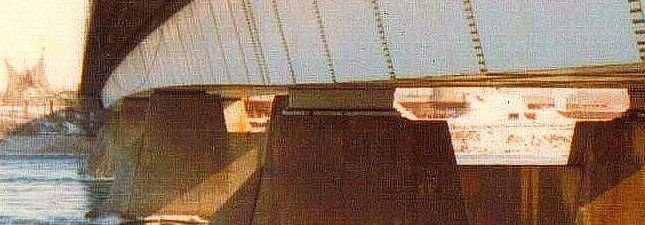However, when we have a steel structure that supports curved metal sheets that combine into a graceful envelope, we have a sculpture, a chimera, but we certainly don't have what I would consider good architecture. None of the formal intentions are integrated with the human functions or with the structural functions. The awkward interiors are a symptom, a flaw in what should be integral.
Beaux-arts buildings and previous baroque buildings use symmetry to create visual and circulation axes within the constraints of construction techniques of the time - stone bearing capacities, structural span possibilities and light and ventilation requirements. For example width was determined by how far light could penetrate from a window to the interior, usually about twenty feet, therefore determining the maximum width of a wing to be approximately forty feet. Within these constraints, the geometry of the building emerged, and we have the Brandenburg gate, Versailles, Chenonceau, and when windows were made higher and larger through the use of flying buttresses there were the great Gothic cathedrals. Other great architectural inventions like domes served multiple functions. These rotated arches let light in from above, allowed huge spans and could be gracefully buttressed by secondary partial domes. The majesty of the byzantine temples of Istanbul remains unsurpassed.
And so why do we glorify sculptural architecture? Because it reflects our culture well. It shows that we can use technology to make things work. Mechanical and electrical systems make these buildings livable. They are large sets, that show wealth and excess. They are celebrity reasons.
As architecture it offends me, seems a bit crass due to the lack of constraint and of restraint. Pretty, sculptural, like the huge ornaments that dot history, like the colossus of Rhodes, the Atomium at Brussels, the large Roman and Roman-inspired triumphant arches. Architecture should be more than sculpture, it must work and live, make shade, shelter while being poetic. It should reflect ingenuity and evolution, and embody discoveries and inventions, discoveries like those inherent in the slight curve of the Parthenon's base and its subtly varying column spacings, the asymmetry of Chartres towers telling the story of its construction and of its builders, the lightness of its interiors, and the balance and poetics of Fallingwater's terraces and its colours and materials that rise with the light.
Beaux-arts buildings and previous baroque buildings use symmetry to create visual and circulation axes within the constraints of construction techniques of the time - stone bearing capacities, structural span possibilities and light and ventilation requirements. For example width was determined by how far light could penetrate from a window to the interior, usually about twenty feet, therefore determining the maximum width of a wing to be approximately forty feet. Within these constraints, the geometry of the building emerged, and we have the Brandenburg gate, Versailles, Chenonceau, and when windows were made higher and larger through the use of flying buttresses there were the great Gothic cathedrals. Other great architectural inventions like domes served multiple functions. These rotated arches let light in from above, allowed huge spans and could be gracefully buttressed by secondary partial domes. The majesty of the byzantine temples of Istanbul remains unsurpassed.
And so why do we glorify sculptural architecture? Because it reflects our culture well. It shows that we can use technology to make things work. Mechanical and electrical systems make these buildings livable. They are large sets, that show wealth and excess. They are celebrity reasons.
As architecture it offends me, seems a bit crass due to the lack of constraint and of restraint. Pretty, sculptural, like the huge ornaments that dot history, like the colossus of Rhodes, the Atomium at Brussels, the large Roman and Roman-inspired triumphant arches. Architecture should be more than sculpture, it must work and live, make shade, shelter while being poetic. It should reflect ingenuity and evolution, and embody discoveries and inventions, discoveries like those inherent in the slight curve of the Parthenon's base and its subtly varying column spacings, the asymmetry of Chartres towers telling the story of its construction and of its builders, the lightness of its interiors, and the balance and poetics of Fallingwater's terraces and its colours and materials that rise with the light.



Architecture, like many living things, is an attempt to defy gravity for a while In fact Wright made the analogy with trees. They manage to combine the height with better light gathering and water moving functions, along with structural wind resistance and are beautiful to look at. I think that when a building combines what we see as balance and beauty with gravity defying functions, like the Fifth Avenue Guggenheim spiral by Wright, where the ramp supports the walls and the lighting and circulation are integrated into the gaps as the ramp expands outwards, we have something new, something natural, something that has optimized the act of creation economically like nature does.